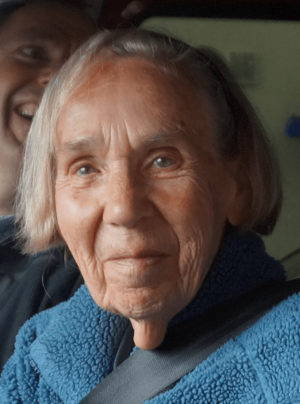Mary Lee Woods facts for kids
Quick facts for kids
Mary Lee Woods
|
|
|---|---|
 |
|
| Born | 12 March 1924 Hall Green, Birmingham, England
|
| Died | 29 November 2017 (aged 93) London, England
|
| Alma mater | University of Birmingham |
| Employer | Telecommunications Research Establishment, Mount Stromlo Observatory, Ferranti |
| Spouse(s) | |
| Children | Sir Tim Berners-Lee (Timothy) Peter Helen Mike Berners-Lee (Michael) |
| Parents |
|
Mary Lee Berners-Lee (born Woods; March 12, 1924 – November 29, 2017) was a brilliant English mathematician and computer scientist. She was part of a team that created programs for some of the earliest computers. These included the Manchester Mark 1, Ferranti Mark 1, and Mark 1 Star computers.
Mary Lee Berners-Lee is also famous for being the mother of two important people. Her son, Sir Tim Berners-Lee, invented the World Wide Web. Her other son, Mike Berners-Lee, is a researcher who studies greenhouse gases.
Early Life and Education
Mary Lee Woods was born in Hall Green, Birmingham, England, on March 12, 1924. Both of her parents, Ida and Bertie Woods, were teachers. She had a brother who sadly died while serving in the Royal Air Force during World War II.
Mary went to Yardley Grammar School. There, she showed a natural talent for mathematics. From 1942 to 1944, she studied math at the University of Birmingham. This was a special two-year course during wartime.
After this, she worked at the Telecommunications Research Establishment in Malvern. In 1946, she went back to university to finish her degree. After graduating, she received a special offer from Richard van der Riet Woolley. She worked at Mount Stromlo Observatory in Canberra, Australia, from 1947 to 1951. Then, she moved to Manchester and joined a company called Ferranti as a computer programmer.
Working at Ferranti
When Mary joined Ferranti, a British electrical engineering company, she became part of a programming team. This team was led by John Makepeace Bennett.
She worked on two early computers: the Ferranti Mark 1 and the Ferranti Mark 1 Star. Writing programs for these machines was very challenging. Programs had to be written in machine code, which meant every single bit of information had to be perfect. Even a tiny mistake could cause the program to fail.
The Ferranti computers had a special way of storing information. They used two levels of storage. There was a fast random-access memory (RAM) and a slower magnetic drum for more storage. Programmers like Mary had to carefully control how data moved between these two storage types. This was slow and had to be done as little as possible.
Finding mistakes in programs for the Ferranti Mark 1 was very hard. Programmers would sit at the computer and watch it run one instruction at a time. This helped them see where things went wrong. But computer time was very valuable. So, Dr. Bennett suggested that Mary write a special program. This program, called 'Stopandprint', would print out information from the computer at certain points. This way, programmers could find errors without using up valuable computer time.
Besides program errors, the computers themselves sometimes made mistakes. They would often misread the binary numbers. This caused arguments between the mathematicians, who wrote the programs, and the engineers, who built the computers. Mary was at the center of one such argument. She had written a program to solve 40 simultaneous equations, which was a huge number for that time. The computer often made errors when processing the large amount of data needed for this calculation.
Mary once complained to Tom Kilburn, a senior engineer. He listened politely but didn't argue. Years later, he told her he didn't argue because he knew she was right.
While at Ferranti, Mary also noticed something unfair. The women in her department were paid less than the men. She spoke to the company's personnel department about this. She successfully convinced them to give women equal pay and rights. This was a big step for equality in the workplace.
Working from Home
Mary left Ferranti in 1955 after her first child was born. She still wanted to work, so she took on smaller programming jobs from home. She called this "cottage industry programming."
One notable project was for the London Transport Executive. She helped create a program to simulate bus routes. This program could help prevent buses from getting stuck or arriving in bunches. She also developed a program for the Royal Air Force (RAF) at Boscombe Down. This program tracked weather balloons and translated their readings.
In 1963, she came out of retirement to work for a company in London called K and H. There, she wrote programming manuals until she retired for good in 1987.
Personal Life
In 1954, Mary married Conway Berners-Lee. She had met him while they both worked at Ferranti. They had four children together: Timothy (Tim), Peter, Helen, and Michael (Mike).
Their oldest son, Sir Tim Berners-Lee, is famous for inventing the World Wide Web. Their youngest son, Mike Berners-Lee, is a university professor and writer.
After raising her children, Mary became a math teacher. Later, she returned to programming, using languages like BASIC and Fortran. She retired in 1987.
Mary Lee Berners-Lee passed away on November 29, 2017, at the age of 93.
See also
 In Spanish: Mary Lee Woods para niños
In Spanish: Mary Lee Woods para niños

